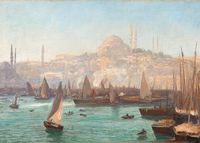About me
Max Constant is literally born, as they are the shortened parts of the first names of K.A.J. Macco’s two sons. They are in the order Max Constant and not Constant Max because being maximally constant is a way of life that was highly regarded by humanists and Stoics in the Early Modern Period. Constant maximum is the opposite and typical of contemporary, fleeting, and capital-oriented market thinking that Max Constant wants to counterbalance. The Early Modern period is particularly interesting because it increasingly saw a cross-fertilization between the western and Christian Europe and the eastern and southern Islamic orient. Max Constant aims to achieve greater self-awareness through understanding others and provide people with tools to navigate the current fast-paced and multicultural society, enabling them to find happiness in a balanced pride in their own identity. The work of the Early Modern philosopher Justus Lipsius, titled De Constantia, had a significant influence on both the name Constant (son Constantin) and the philosophy of K.A.J. Macco. Its influence can be observed at various points in Macco’s work.
The names are meaningful for even more reasons, because Maximilian (Max) is a name inspired by the Habsburg Emperor Maximilian I (1459-1519), who ruled over the Netherlands from 1482 onwards. Maximilian ensured that these regions became part of the Habsburg Empire through strategic marriages between his grandchildren and the children of Wladislaus (who ruled over Hungary and Bohemia). Bohemia is also the region where the ‘Macco’ lineage originates. German sources trace back to the early 16th century, during Maximilian I’s reign. Bohemia was a border area between Germanic and Slavic peoples and historically a region with many conflicts. The potential friction in intercultural contacts has therefore been ingrained in the blood of the Macco lineage for many generations, notably expressed in the orientalist art of Georg Macco (1863-1933).
A well-known work by the orientalist artist Georg Macco - a German branch of the Macco family and tracing back to the same ancestor as K.A.J. Macco - is the painting ‘Golden Horn of Constantinople’. The city - founded by Roman Emperor Constantine the Great after a vision in 330 AD - had fallen six years before the birth of Emperor Maximilian I and was conquered by the Turks. The fall of that city caused a great European-Christian trauma where Maximilian I grew up. This is because it was considered as the second Rome that could never be taken. At many parties, he must have heard as a little boy chanting of the ‘Mare Nostrum’, the ‘our [Mediterranean] sea.’ This traumatic event of an aggressive expansion of the Sunni-Islamic Ottoman Empire also gave rise to the Renaissance. Without the works hidden deep in the library of Constantinople and smuggled out of the city by monks, we probably would never have been able to read ‘De Constantia’ by Justus Lipsius, and Renaissance Humanism would not have flourished in this way. To encompass all these meanings and to bridge the gap between Catholic-Christian Europe and the Orthodox-Christian part of the world, the second son was named Constantin. Named after the city that forms a bridge between East and West: Constantinople.
Golden Horn of Constantinople, by Georg Macco.
Also check on Academia.edu and LinkedIn for background information about K.A.J. Macco.
